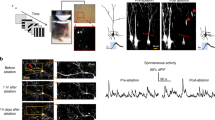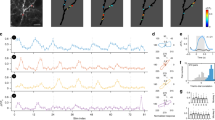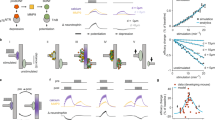Abstract
The thin basal and oblique dendrites of cortical pyramidal neurons receive most of the synaptic inputs from other cells, but their integrative properties remain uncertain. Previous studies have most often reported global linear or sublinear summation. An alternative view, supported by biophysical modeling studies, holds that thin dendrites provide a layer of independent computational 'subunits' that sigmoidally modulate their inputs prior to global summation. To distinguish these possibilities, we combined confocal imaging and dual-site focal synaptic stimulation of identified thin dendrites in rat neocortical pyramidal neurons. We found that nearby inputs on the same branch summed sigmoidally, whereas widely separated inputs or inputs to different branches summed linearly. This strong spatial compartmentalization effect is incompatible with a global summation rule and provides the first experimental support for a two-layer 'neural network' model of pyramidal neuron thin-branch integration. Our findings could have important implications for the computing and memory-related functions of cortical tissue.
This is a preview of subscription content, access via your institution
Access options
Subscribe to this journal
Receive 12 print issues and online access
$209.00 per year
only $17.42 per issue
Buy this article
- Purchase on Springer Link
- Instant access to full article PDF
Prices may be subject to local taxes which are calculated during checkout





Similar content being viewed by others
References
Hausser, M., Spruston, N. & Stuart, G.J. Diversity and dynamics of dendritic signaling. Science 290, 739–744 (2000).
Magee, J., Hoffman, D., Colbert, C. & Johnston, D. Electrical and calcium signaling in dendrites of hippocampal pyramidal neurons. Annu. Rev. Physiol. 60, 327–346 (1998).
Rhodes, P.A. Functional implications of active currents in the dendrites of pyramidal neurons. in Cerebral Cortex Vol. 13 (eds. Ulinski, P.S., Jones, E.G. & Peters, A.) 139–200 (Kluwer Academic Press, New York, 1999).
Reyes, A. Influence of dendritic conductances on the input-output properties of neurons. Annu. Rev. Neurosci. 24, 653–675 (2001).
Schiller, J. & Schiller, Y. NMDA receptor-mediated dendritic spikes and coincident signal amplification. Curr. Opin. Neurobiol. 11, 343–348 (2001).
Migliore, M. & Shepherd, G.M. Emerging rules for the distributions of active dendritic conductances. Nat. Rev. Neurosci. 3, 362–370 (2002).
Johnston, D., Magee, J., Colbert, C. & Cristie, B.R. Active properties of neuronal dendrites. Annu. Rev. Neurosci. 19, 165–186 (1996).
Margulis, M. & Tang, C.M. Temporal integration can readily switch between sublinear and supralinear summation. J. Neurophysiol. 79, 2809–2813 (1998).
Urban, N.N. & Barrionuevo, G. Active summation of excitatory postsynaptic potentials in hippocampal CA3 pyramidal neurons. Proc. Natl. Acad. Sci. USA 95, 11450–11455 (1998).
Cash, S. & Yuste, R. Linear summation of excitatory inputs by CA1 pyramidal neurons. Neuron 22, 383–394 (1999).
Magee, J.C. Dendritic integration of excitatory synaptic input. Nat. Rev. Neurosci. 1, 181–190 (2000).
Nettleton, J.S. & Spain, W.J. Linear to supralinear summation of AMPA-mediated EPSPs in neocortical pyramidal neurons. J. Neurophysiol. 83, 3310–3322 (2000).
Oakley, J.C., Schwindt, P.C. & Crill, W.E. Dendritic calcium spikes in layer 5 pyramidal neurons amplify and limit transmission of ligand-gated dendritic current to soma. J. Neurophysiol. 86, 503–513 (2001).
Tamas, G. Szabadics, J. & Somogyi, P. Cell type- and subcellular position dependent summation of unitary postsynaptic potentials in neocortical neurons. J. Neurosci. 22, 740–747 (2002).
Hausser, M. & Mel, B.W. Dendrites: bug or feature. Curr. Opin. Neurobiol. 13, 372–383 (2003).
Cauller, L.J. & Connors, B.W. Synaptic physiology of horizontal afferents to layer I in slices of rat SI neocortex. J. Neurosci. 14, 751–762 (1994).
Schiller, J., Schiller, Y., Stuart, G. & Sakmann, B. Calcium action potentials restricted to distal apical dendrites of rat neocortical pyramidal neurons. J. Physiol. 505, 605–616 (1997).
Larkum, M.E., Zhu, J.J. & Sakmann, B. A new cellular mechanism for coupling inputs arriving at different cortical layers. Nature 398, 338–341 (1999).
Oviedo, H. & Reyes, A.D. Boosting of neuronal firing evoked with asynchronous and synchronous inputs in the dendrite. Nat. Neurosci. 5, 261–266 (2002).
Williams, S.R. & Stuart, G.J. Dependence of EPSP efficacy on synapse location in neocortical pyramidal neurons. Science 295, 1907–1910 (2002).
Bernander, O., Koch, C. & Douglas, R.J. Amplification and linearization of distal synaptic input to cortical pyramidal cells. J. Neurophysiol. 70, 2743–2753 (1994).
Cook, E.P. & Johnston, D. Voltage-dependent properties of dendrites that eliminate location-dependent variability of synaptic input. J. Neurophysiol. 81, 535–543 (1999).
Magee, J.C. Dendritic Ih normalizes temporal summation in hippocampal CA1 neurons. Nat. Neurosci. 2, 508–514 (1999).
Magee, J.C. & Cook, E.P. Somatic EPSP amplitude is independent of synapse location in hippocampal pyramidal neurons. Nat. Neurosci. 3, 895–903 (2000).
Larkman, A.U. Dendritic morphology of pyramidal neurons of the rat: spine distribution. J. Comp. Neurol. 306, 332–343 (1991).
Megias, M., Emri, Z., Freund, T.F. & Gulyas, A.I. Total number and distribution of inhibitory and excitatory synapses on hippocampal CA1 pyramidal cells. Neuroscience 102, 527–540 (2001).
Beaulieu, C. & Colonnier, M. A laminar analysis of the number of round-asymmetrical and flat-symmetrical synapses on spines, dendritic trunks, and cell bodies in area 17 of the cat. J. Comp. Neurol. 231, 180–189 (1985).
Schiller, J., Major, G., Koester, H.J. & Schiller, Y. NMDA spikes in basal dendrites of cortical pyramidal neurons. Nature 404, 285–289 (2000).
Wei, D-S. et al. Compartmentalized and binary behavior of terminal dendrites in hippocampal pyramidal neurons. Science 293, 2272–2275 (2001).
Ariav, G., Polsky, A. & Schiller, J. Submillisecond precision of the input-output information function mediated by fast sodium dendritic spikes in basal dendrites of CA1 pyramidal neurons. J. Neurosci. 23, 7750–7758 (2003).
Poirazi, P., Brannon, T. & Mel, B.W. Arithmetic of subthreshold synaptic summation in a model CA1 pyramidal cell. Neuron 37, 977–987 (2003).
Poirazi, P., Brannon, T. & Mel, B.W. Pyramidal neuron as two-layer network. Neuron 37, 989–999 (2003).
McClelland, J.L. & Rumelhart, D.E. Distribution memory and the representation of general and specific information. J. Exp. Psychol. Gen. 114, 159–197 (1985).
Kepecs, A., Wang, X.J. & Lisman, J. Bursting neurons signal input slope. J. Neurosci. 22, 9053–9062 (2002).
Mel, B.W. The clusteron: toward a simple abstraction for a complex neuron. in Advances in Neural Information Processing Systems, Vol. 4 (eds. Moody, J., Hanson, S. & Lippmann, R.) 35–42 (Morgan Kaufmann, San Mateo, CA, 1992).
Poirazi, P. & Mel, B.W. Impact of active dendrites and structural plasticity on the memory capacity of neural tissue. Neuron 29, 779–796 (2001).
Koch, C., Poggio, T. & Torre, V. Nonlinear interaction in a dendritic tree: localization, timing and role of information processing. Proc. Natl. Acad. Sci. USA 80, 2799–2802 (1983).
Rall, W. & Segev, I. Functional possibilities for synapses on dendrites and on dendritic spines. in Synaptic Function (eds. Edelman, G., Gall, W. & Cowan, W.) 605–636 (Wiley, New York, 1987).
Shepherd, G.M. & Brayton, R. Logic operations are properties of computer-simulated interactions between excitable dendritic spines. Neuroscience 21, 151–165 (1987).
Archie, K.A. & Mel, B.W. An intradendritic model for computation of binocular disparity. Nat. Neurosci. 3, 54–63 (2000).
Mel, B.W., Ruderman, D.L. & Archie, K.A. Translation-invariant orientation tuning in visual 'complex'cells could derive from intradendritic computations. J. Neurosci. 18, 4325–4334 (1998).
Euler, T., Detwiler P.B. & Denk, W. Directionally selective calcium signals in dendrites of starburst amacrine cells. Nature 418, 845–852 (2002).
Borg-Graham, L.J. & Grzywacz, N. A model of the direction selectivity circuit in retina: transformations by neurons singly and in concert. in Single Neuron Computation (eds. McKenna, T., Davis, J. & Zornetzer, S.F.) 347–375 (Academic Press, Cambridge, Massachusetts, 1992).
Single, S. & Borst, A. Dendritic integration and its role in computing image velocity. Science 281, 1848–1850 (1998).
Acknowledgements
We thank M. Hausser, M. London and Y. Schiller for their helpful comments on an earlier version of the manuscript. This study was supported by the National Institutes of Health, Israeli Science Foundation, National Science Foundation and the Rappaport Foundation.
Author information
Authors and Affiliations
Corresponding author
Ethics declarations
Competing interests
The authors declare no competing financial interests.
Rights and permissions
About this article
Cite this article
Polsky, A., Mel, B. & Schiller, J. Computational subunits in thin dendrites of pyramidal cells. Nat Neurosci 7, 621–627 (2004). https://doi.org/10.1038/nn1253
Received:
Accepted:
Published:
Issue Date:
DOI: https://doi.org/10.1038/nn1253
This article is cited by
-
Recent progress in three-terminal artificial synapses based on 2D materials: from mechanisms to applications
Microsystems & Nanoengineering (2023)
-
Cortico-cortical feedback engages active dendrites in visual cortex
Nature (2023)
-
Introducing the Dendrify framework for incorporating dendrites to spiking neural networks
Nature Communications (2023)
-
Generalized extinction of fear memory depends on co-allocation of synaptic plasticity in dendrites
Nature Communications (2023)
-
Improving a cortical pyramidal neuron model’s classification performance on a real-world ecg dataset by extending inputs
Journal of Computational Neuroscience (2023)



